 |
Convert OGV to MOV/QuickTime
|
OGV to MOV Converter Software converts OGV files to MOV
with H.264 or MPEG-4 video codecs. The MOV is QuickTime File Format (QTFF) used
natively by the QuickTime application. The MOV is very common on Mac OS like WMV
on Windows. It's a great tool for converting format when transferring file to
Mac OS. The OGV to MOV Converter Software also supports other video, audio,
and device formats, for example, AVI, FLAC, MP2, SPX (Speex), 3G2, PPM image sequence, M4B (MPEG-4 audiobook), etc.
The software could convert 3GP to Windows Phone, M2TS to TS, DIVX to ALAC (Apple Lossless), AVI to Android Tablet, DVD to FLAC,
and so on.
OGV to MOV Converter Software supports batch conversion and, is compatible
with Windows 10/8/7/Vista/XP/2000 (both x86 and 64-bit platforms).

What is OGV?
Video file that uses the Xiph.Org's open source Ogg container format; may
contain video streams that use one or more different codecs, such as Theora;
can be played using a variety of media players. Theora is in full public
release as of November 3, 2008. The bitstream format for Theora I was frozen
Thursday, 2004 July 1. All bitstreams encoded since that date will remain
compatible with future releases. Theora supports intra-coded frames and
forward-predictive frames, but not bi-predictive frames which are found
in H.264 and VC-1. Theora is named for Theora Jones, Edison Carter's Controller
on the Max Headroom television program. Theora is derived from the proprietary
VP3 codec, released into the public domain by On2 Technologies. It is broadly
comparable in design and bitrate efficiency to MPEG-4 Part 2, early versions
of Windows Media Video, and RealVideo while lacking some of the features
present in some of these other codecs. It is comparable in open standards
philosophy to the BBC's Dirac codec. However there are currently no Theora
decoder chips in production, and portable media players, smartphones and
similar devices with limited computing power rely on such chips to provide
efficient playback. Theora is an open and royalty-free lossy video compression
technology being developed by the Xiph.Org Foundation as part of their
Ogg project. Based upon On2 Technologies' VP3 codec, Theora competes with
MPEG-4, WMV, and similar low-bitrate video compression schemes. The Theora
I bitstream format was frozen in June 2004 after the libtheora 1.0alpha3
release. VP3 video compression can be decoded using Theora implementations,
but Theora video compression usually cannot be decoded using old VP3 implementations.
What is MOV?
MOV is a file extension used by the QuickTime-wrapped files. The format
was created by Apple Computer to work with multimedia files. The ability
to contain abstract data references for the media data, and the separation
of the media data from the media offsets and the track edit lists means
that QuickTime is particularly suited for editing, as it is capable of
importing and editing in place (without data copying). Of course, compressing
a MOV file can help save storage space and make it easier to download and
distribute the video file. As a multimedia stardand, QuickTime is not purely
linear. It could contain interactivity and causes problems when converting
to other video formats. MOV files are played on a QuickTime Video player.
QuickTime player is a free media player developed by Apple and is available
for Windows and Mac OS X systems. This easy-to-use player allows you to
play your MOV files of different sizes and aspect ratios at high resolutions.
Watch your standard or high-definition MOV files in the best way possible.
It also accepted by Windows-based systems. Most media players and video
editors accept the .mov movie format, making it one of the most versatile
formats available on your computer. Tracks are maintained in a hierarchical
data structure consisting of objects called atoms. An atom can be a parent
to other atoms or it can contain media or edit data, but it cannot do both.
Though MOV files are quite often found in the web, to play them on Windows
computer one has to install an extra component or convert to other format.
The multimedia container files store audio, video, text and more for specific
use with the Mac operating system.
How to Convert OGV to MOV/QuickTime?
- Free Download OGV to MOV Converter
Software
- Install the Program by Step-by-step Instructions
- Launch OGV to MOV Software
- Choose OGV Files

Click "Add Files" to choose OGV files.

Choose one or more OGV files you want to convert and then click Open.
OGV to MOV Software will open OGV files and get file information
of the file such as width, height, frame rate, video bit rate, audio sample rate,
audio bit rate, audio channels, and then display the information of OGV file
at conversion list.
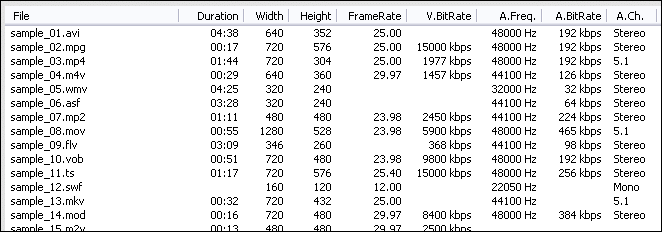
- Choose Output Format
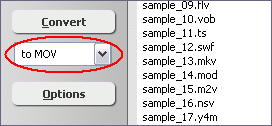
Click on combo box of output format and then choose "to MOV".
- [Optional, for advanced user]
Set MOV Encoding Parameters
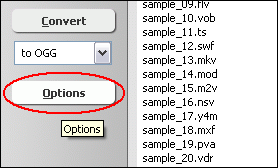
If you want to change MOV encoding parameters such as video codec, bit rate,
frame rate, video size, aspect ratio, audio codec, and so on, please click "Options".
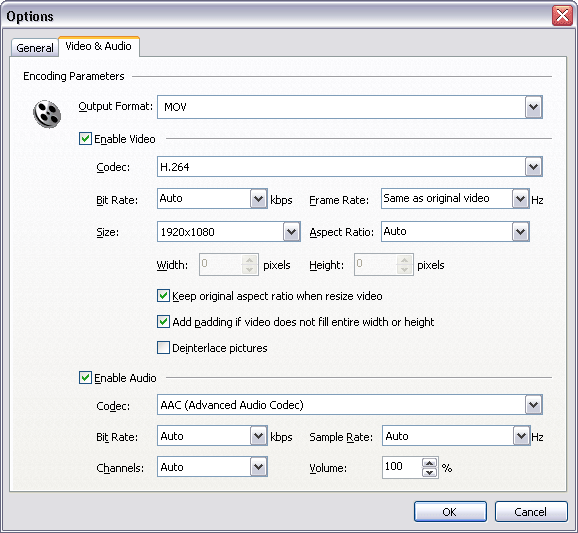
And then, switch to tab "Video & Audio" and choose "MOV"
at "Output Format", and then set options for video and audio
encoding.
You could choose H.264 or MPEG-4 for video codec. The audio codec is AAC only.
- Convert OGV to MOV
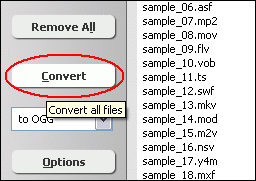
Click "Convert" to convert all OGV files in list to MOV format.

The software is converting OGV files to MOV.
- Play and Browse MOV File
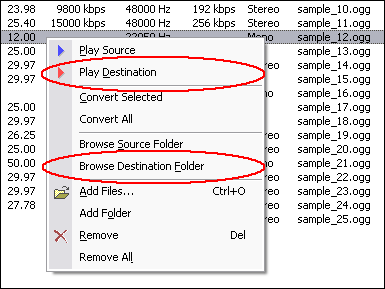
When conversion completes, you can right-click converted item and choose "Play
Destination" to play the outputted MOV file; or choose "Browse Destination
Folder" to open Windows Explorer to browse the outputted MOV file.
- Done
Top
OGV to MOV Software is 100% clean and safe to
install. It's certified by major download sites.

Convert OGV to MOV/QuickTime Related Topics:
|











